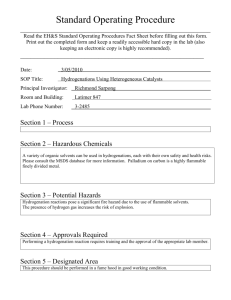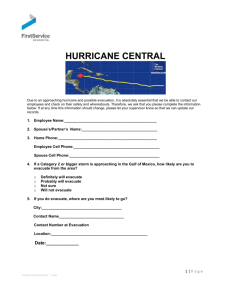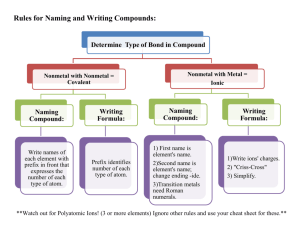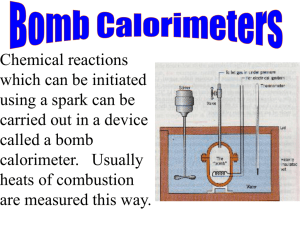Metal Hydrides and Hydrogenation Catalyst
advertisement
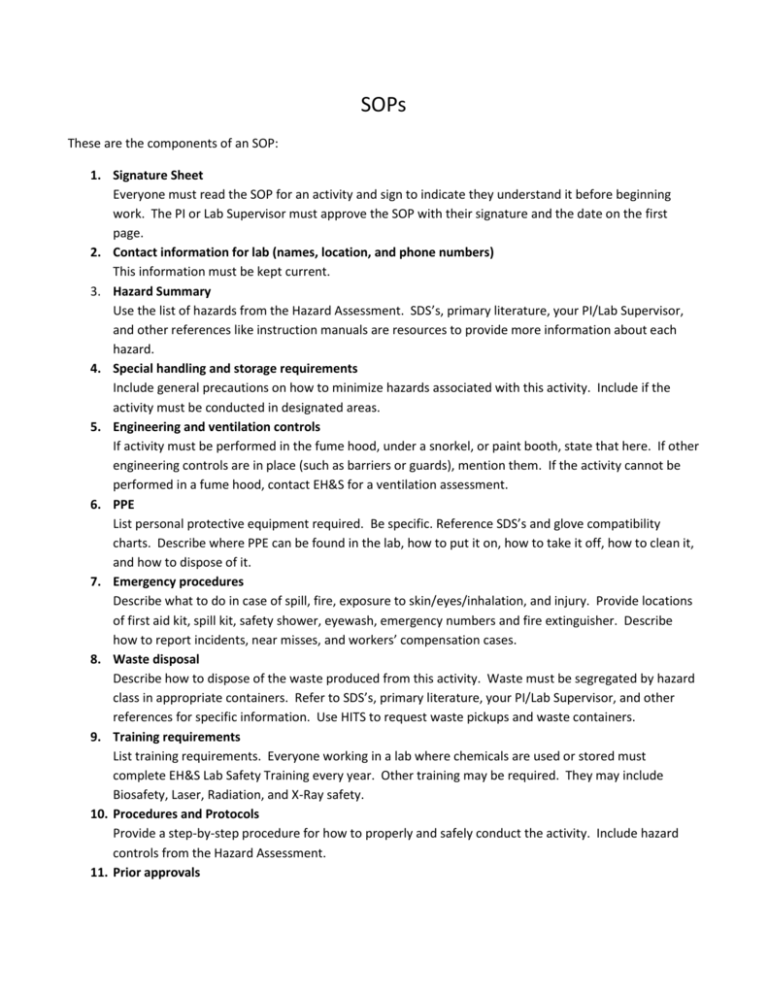
SOPs These are the components of an SOP: 1. Signature Sheet Everyone must read the SOP for an activity and sign to indicate they understand it before beginning work. The PI or Lab Supervisor must approve the SOP with their signature and the date on the first page. 2. Contact information for lab (names, location, and phone numbers) This information must be kept current. 3. Hazard Summary Use the list of hazards from the Hazard Assessment. SDS’s, primary literature, your PI/Lab Supervisor, and other references like instruction manuals are resources to provide more information about each hazard. 4. Special handling and storage requirements Include general precautions on how to minimize hazards associated with this activity. Include if the activity must be conducted in designated areas. 5. Engineering and ventilation controls If activity must be performed in the fume hood, under a snorkel, or paint booth, state that here. If other engineering controls are in place (such as barriers or guards), mention them. If the activity cannot be performed in a fume hood, contact EH&S for a ventilation assessment. 6. PPE List personal protective equipment required. Be specific. Reference SDS’s and glove compatibility charts. Describe where PPE can be found in the lab, how to put it on, how to take it off, how to clean it, and how to dispose of it. 7. Emergency procedures Describe what to do in case of spill, fire, exposure to skin/eyes/inhalation, and injury. Provide locations of first aid kit, spill kit, safety shower, eyewash, emergency numbers and fire extinguisher. Describe how to report incidents, near misses, and workers’ compensation cases. 8. Waste disposal Describe how to dispose of the waste produced from this activity. Waste must be segregated by hazard class in appropriate containers. Refer to SDS’s, primary literature, your PI/Lab Supervisor, and other references for specific information. Use HITS to request waste pickups and waste containers. 9. Training requirements List training requirements. Everyone working in a lab where chemicals are used or stored must complete EH&S Lab Safety Training every year. Other training may be required. They may include Biosafety, Laser, Radiation, and X-Ray safety. 10. Procedures and Protocols Provide a step-by-step procedure for how to properly and safely conduct the activity. Include hazard controls from the Hazard Assessment. 11. Prior approvals If the PI/Lab Supervisor must approve the activity, indicate it here. Also indicate if working alone is permitted. A blank template is on the next page. Template SOPs with basic information already filled out are available in the EH&S website. SAFETY OPERATING PROCEDURE TEMPLATE By signing and dating here the Principal Investigator/ or a designee certifies that the Safety Operating Procedure (SOP) for Metal Hydrides, Palladium on Carbon (Pd/C), Platinum on Carbon (Pt/C), Raney nickel (RaNi) is accurate and effectively provides guidance for employees and students in this lab. _________________________________________________________________________ Printed Name Signature Date I affirm that I have read and understand the Safety Operating Procedure for Metal Hydrides, Palladium on Carbon (Pd/C), Platinum on Carbon (Pt/C), Raney nickel (Ra-Ni) and have undergone the EH&S Laboratory & Research training and any lab specific training regarding this SOP. Printed Name Signature Date CONTACT INFORMATION Location Street Address: Lab Safety Contact: Emergency Contact Building: Room: Name: Lab Phone: Name: Office Phone: Phone: HAZARD SUMMARY List physical, chemical, and health hazards associated with the chemical, chemical class, process, or machine. Palladium on carbon is a highly flammable finely divided metal. Palladium on Carbon is used as a hydrogenation catalyst. Absorbed hydrogen during the process of hydrogenation makes it pyrophoric. It may ignite spontaneously when dried in air. The use of flammable solvents and hydrogen gas during the process of hydrogenation increases the risk of fire and explosion. GHS Hazard Statement H317 May cause an allergic skin reaction. Precautionary statement(s) P261 Avoid breathing dust/ fume/ gas/ mist/ vapors/ spray. P272 Contaminated work clothing should not be allowed out of the workplace. P280 Wear protective gloves. P302 + P352 IF ON SKIN: Wash with plenty of soap and water. P333 + P313 If skin irritation or rash occurs: Get medical advice/ attention. P363 Wash contaminated clothing before reuse. P501 Dispose of contents/ container to an approved waste disposal plant. SPECIAL HANDLING AND STORAGE REQUIREMENTS Include general precautions on how to minimize hazards associated with this activity. Dry solid materials may result in the formation of combustible dusts. The potential for combustible dust formation should be taken into consideration before additional processing occurs. Use in paste form (50-60% moisture) when the presence of water is not detrimental to the process. Avoid heat, flames and sparks. The catalytic properties of this material will promote the oxidation and possible ignition of flammable liquids and vapors. The dehydrogenation of the lower alcohols (methanol) and compounds such as cyclohexane may readily cause ignition. After use, all catalysts which contain absorbed hydrogen may ignite when dried in air, especially in the presence of organic material. Incompatible with alcohols, strong acids, bases, oxidizing agents. Palladium undergoes a violent reaction with arsenic. Contact with Hydrogen gas together with air will cause fire and explosion. In case of fire use water spray, alcohol-resistant foam, dry chemical or carbon dioxide Air and moisture sensitive. Handle and store under inert gas. Keep in a dry place. Storage class (TRGS 510): Non Combustible Solids ENGINEERING AND VENTILATION CONTROLS Specify if the activity must be conducted using a fume hood, snorkel, or paint booth; or in a well-ventilated area. Word under an inert atmosphere (argon, nitrogen), in a glove box, manifold, or an enclosed inert environment within a fume hood. Provide appropriate exhaust ventilation at places where dust is formed. Reactions under pressure should be placed behind a blast shield unless they are in a bomb reactor rated to withstand the reaction pressure. PERSONAL PROTECTIVE EQUIPMENT PPE Requirements: ☒ Long pants or clothing that covers all skin below the waist ☒ Shoes that cover the entire foot ☒ Gloves; indicate type: Click here to enter text. Inspect gloves before use. Use proper glove removal technique to avoid skin contact with outer surface of glove. Wash hands after removing gloves. ☐ Safety goggles ☒ Safety glasses ☐ Face shield ☒ Lab coat ☐ Flame-resistant lab coat ☐ Other: Click here to enter text. If the use of an N95, half mask, or full face respirator is requested, the individual and/or their supervisor must first contact Environmental Health & Safety for a consultation to determine if respirator use is necessary. If EH&S determines the use of a respirator is necessary, the individual must participate in the University’s respirator program. This includes a medical evaluation; respirator fit test, and training. EMERGENCY PROCEDURES In case of fire or large and/or extremely hazardous chemical releases pull the fire alarm and evacuate the area If someone is seriously injured or unconscious CALL 911 or CAMPUS POLICE AT 813-974-2628 From a safe place, provide as much information as possible to the emergency responders including chemical name, volume, hazards, injuries, and location. In case of small fires, Metal-X, soda ash, or sand can be used. In case of a large fire, use a CO2 or ABC fire extinguisher. Do not use water if the reaction was run in a non-alcoholic solvent. In case of an explosion, close the sash of the fume hood. An explosion during a hydrogenation usually expels the contents of the reaction vessel, which can lead to a fire. Be prepared to extinguish a fire. If the contents do not immediately ignite, use a large volume of water or sand to quench the catalyst. Chemical Exposure: Remove any contaminated clothing, and IMMEDIATELY flush contaminated skin with water for at least 15 minutes following any skin contact. For eye exposures, IMMEDIATELY flush eyes with water for at least 15 minutes. Consult SDS for guidance on appropriate first aid. Where medical attention is required, bring the SDS(s) of chemical(s) to aid medical staff in proper diagnosis and treatment. Evacuation Procedure Immediately evacuate the building via the nearest exit when the fire alarm is activated. If unable to evacuate due to a disability, shelter in the area of rescue / refuge, typically a stairwell landing, and wait for assistance from drill volunteers or emergency responders. Instruct visitors and students to evacuate and assist them in locating the nearest exit. Do not use elevators to exit the building during an evacuation as they may become inoperable. Carry only those personal belongings that are within the immediate vicinity. Close doors to limit the potential spread of smoke and fire. Terminate all hazardous operations and power off equipment. Close all hazardous materials containers. Remain outside of the building until the building is released for reentry. Do not restrict or impede the evacuation. Convene in the designated grassy gathering area and await instruction from emergency responders or drill volunteers. Avoid parking lots. Report fire alarm deficiencies, (e.g., trouble hearing the alarm) to facilities personnel for repair. Notify evacuation drill volunteers or emergency responders of persons sheltering in the areas of rescue/ refuge. Never assume that an alarm is a “false alarm”. Treat all fire alarm activations as emergencies. Get out of the building! Incident and Near Miss Reporting: The Laboratory/Studio and Field Incident Report form is to be completed within 24 hours for any incident that occurs in any University of South Florida affiliated teaching or research laboratory/studio or field research project. An incident means any unplanned event within the scope of a procedure that causes, or has the potential to cause, an injury or illness and/or damage to equipment, buildings, or the natural environment. Due to medical privacy concerns, no personal identifying information of the person involved in the incident shall be entered or submitted with the form. http://www.usf.edu/administrative-services/environmental-health-safety/laboratory-safety/incidents.aspx Workers’ Compensation Procedure: Call AmeriSys at 800-455-2079 to report a work-related injury or illness. Complete the Supervisor’s Accident Investigation Report available from the Human Resources website. WASTE DISPOSAL Describe how to dispose of the chemical waste produced from this activity. All used, filtered catalysts should be kept wet and out of contact with combustible liquids and vapors. Palladium waste should be separated from the mixture and placed in a labeled container that contains water. Any filtration aids such as Celite should also be discarded in the palladium waste stream. It is important to make sure any solid waste from a hydrogenation has been exposed to water prior to disposal All chemical waste generated within USF System laboratories is considered hazardous waste and must be disposed of as hazardous waste in accordance with USF Hazardous Waste Management Procedure, the EPA, and the DEP. The USF Hazardous Waste Management Procedure can be found using the following link, http://www.usf.edu/administrative-services/environmental-health-safety/hazardous-waste/index.aspx TRAINING REQUIREMENTS All individuals working with chemicals in USF laboratories must take EH&S’s Laboratory & Research Safety Training. To register for Laboratory & Research Training, please use the following link: http://www.usf.edu/administrative- services/environmental-health-safety/laboratory-safety/lab-safetytraining2.aspx. However, the use of this chemical may warrant additional safety training per the PI, EH&S, or an authorizing unit such as the Biosafety or Radiation Safety programs. Check training requirements for this activity below: ☒Research Specific Training from the PI/Lab Supervisor or their designee ☒EH&S Laboratory & Research Safety Training ☐EH&S Safety and Compliance in the Arts ☐EH&S Respirator Fit Test ☐EH&S Biomedical Waste ☐EH&S Universal Pharmaceutical Waste Testing ☐EH&S Fire Prevention Safety ☐EH&S Slips, Trips, and Falls ☐RIC Biosafety Core Course ☐RIC Shipping Biohazardous Materials ☐RIC BSL 3 ☐RIC Radiation Safety ☐RIC Laser Safety ☐RIC Boating Safety ☐RIC Scientific Diving ☐Other:_________________________ PROCEDURES AND PROTOCOLS Provide a step-by-step procedure for how to properly and safely conduct the activity. When setting up a hydrogenation reaction, the Pd/C should be added first and the vessel flushed with an inert gas. Then add the solvent. The inert gas should be introduced first, followed by the hydrogen gas. Or wet the Pd/C with water before adding the solvent. If the hydrogenation reaction is run under pressure, use a blast shield. If the reaction mixture is filtered through Celite or other filtration aid, do not let the filter cake dry out or it may ignite. Wash with water after solvent removal and do not allow to dry. Hydrogenation using a balloon: 1) Evacuate the reaction vessel (this should have at least two openings) and backfill with an inert gas (nitrogen or argon). 2) Weigh out the desired amount of Pd/C and transfer into the reaction flask under an inert atmosphere. 3) Add a small amount of ethyl acetate, dichloromethane, or toluene to the reaction flask, making sure to wash down any Pd/C stuck to the flask walls. All the Pd/C should be submerged at this point. 4) Carefully add methanol by creating a stream down the side of the flask wall. 5) Add the reaction substrate either as a solution or neat. 6) Begin stirring the reaction mixture and then evacuate the flask just until the solvent begins to bubble, then carefully backfill with inert gas. 7) Repeat step 6 twice more. 8) Attach a balloon of hydrogen to your flask with an adapter that allows the balloon to be closed off from the reaction flask. 9) With the hydrogen balloon closed off, evacuate the flask until the solvent begins to bubble, and then open the balloon to the flask. 10) Repeat step 9 twice more. Hydrogenation using a bomb reactor: 1) Purge the bomb with inert gas, and then follow steps 2-5 from the procedure above (“hydrogenation using a balloon”). 2) Seal the bomb under an inert atmosphere and then evacuate it using a mild vacuum source. Close the bomb off from the vacuum source and take it to the hydrogen source. 3) Connect the bomb directly to the hydrogen tank regulator using threaded fittings and fill the bomb with hydrogen up to the desired pressure (use the gauge on the bomb to determine the reaction pressure). 4) Close the bomb off from the hydrogen source so that it is now sealed. Close off the hydrogen cylinder using the regulator on the hydrogen tank, and disconnect your bomb from the regulator. Workup: 1) For balloon reactions: Detach the hydrogen balloon from the flask and fill with inert atmosphere. For bomb reactions: Connect a vent line to the bomb and then run the vent line to the back of the fume hood. Then slowly and carefully vent the reaction mixture to atmospheric pressure. 2) Filter the reaction mixture through a bed of Celite (or similar filter aid) 3) Taking care not to let the filter cake filter to dryness, wash with the desired solvent (typically the same solvent used in the reaction) 4) Disconnect the filter from the receiving flask, and then add several mL of water to the filter. 5) Discard the slurried Pd/C and filter aid in a dedicated waste jar that contains water. NOTE: If you must add catalyst to solution, prepare a slurry of Pd/C in dichloromethane or toluene (using steps 1-3 above) and then add this slurry to your reaction mixture. However, this should not be seen as a preferred method. Protocol obtained from UC Berkeley website: http://www.google.com/url?sa=t&rct=j&q=&esrc=s&source=web&cd=3&ved=0CCwQFjAC&url=http%3A%2F%2F www.cchem.berkeley.edu%2Frsgrp%2FSOPs%2FHydrogenation.doc&ei=OYkIVZy4A8vEggSVpYSoBw&usg=AFQjC NFfszAdSSOarDVVuIcm8JO3lSB50Q&bvm=bv.88198703,d.eXY&cad=rja PRIOR APPROVALS ☐ This activity requires prior approval from the PI/designee. ☐ If this box is checked, working alone is not allowed. Approval Signature (if required by PI) _________________________________________________________
